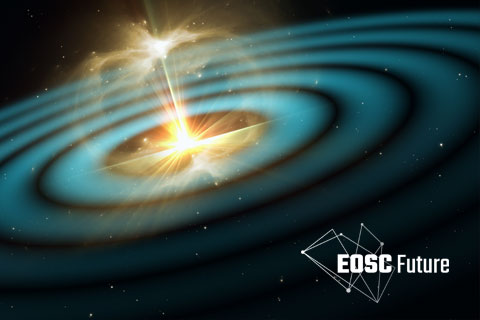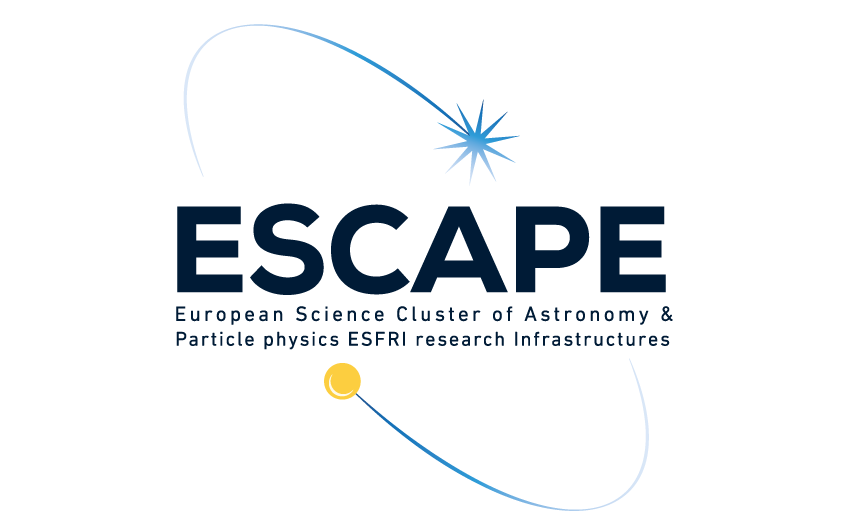
ESCAPE services will eventually contribute to the EOSC (European Open Science Cloud) implementation and the mechanism for that migration will be the EOSC-Future project, within which ESCAPE will one of the science drivers.
Within ESCAPE, two large “Science Projects” (SPs), known as Dark Matter and Extreme Universe and Gravitational Waves will be deployed with a number of high-level objectives:
- To demonstrate new cutting-edge science capabilities, in particular those involving inter-Research Infrastructures collaboration and science outcomes;
- To validate on behalf of the science communities, that the software, tools, services, and infrastructure developed within ESCAPE are what is required by the science use cases;
- To provide feedback to the ESCAPE project, and ultimately to the EOSC community, that will help guide the future direction and development of the EOSC.
The ESCAPE objectives are supported by the thematic consortia (ECFA, APPEC, ASTRONET, NuPECC and the collaboration of those bodies within JENAA). The European Strategy for Particle Physics update in 2020 made it clear that at the highest level, synergies between these research infrastructures should be encouraged and strengthened, and ESCAPE is a visible mechanism for that.
SPs in ESCAPE and EOSC-Future
ESCAPE also intends to investigate a coherent bridge between the two SPs. For example:
- Through Gravitational Waves that may probe the particle nature of dark matter, e.g. via Black Hole environments;
- The properties of extreme nuclear matter via neutron star mergers;
- New physics in the early universe via phase transitions.
Within EOSC-Future, ESCAPE aims to integrate the SPs in a proto-EOSC environment where particle physicists, astrophysicists and astronomers, experimentalists as well as theorists, with a wide range of interests, can exploit synergies and complementarities across different communities for mutual benefit. This aims to develop a multi-probe and cross-domain Open Science Cloud environment.
As well as supporting the continuation and consolidation of the key ESCAPE deliverables (data and software catalogues, analysis platforms) the inclusion of existing cooperative frameworks such as the Virtual Observatory, the CERN OpenData portal and ESO platforms, would further strengthen such a platform for the long-term.
Technical objectives
The sustainable, long-term management, curation, comparison and scientific exploitation of data of the next generation ESFRI facilities are key objectives of the ESCAPE approach. The aim is to maximize the exposure to multi-messenger and multi-probe data from astronomy and accelerator-based particle and nuclear physics for the open science challenges of a new generation of researchers.
Since the two SPs do not neatly sit within a single RI, resources will be provided via EOSC-Future, EGI-ACE and OPENAIRE-Nexus, along with a procurement funding within ESCAPE that can also be a part of the resource provision.
Building blocks: ESCAPE Services Required for the SPs
The 2 SPs will make use of a variety of ESCAPE services, to demonstrate that they enable the required scientific functionality, which will be deployed within the EOSC context to ensure that the ESCAPE “EOSC cell” is fully compatible with the long term EOSC environment. The ESCAPE Services considered are:
- ESCAPE Data Infrastructure for Open Science (DIOS)
- A fully developed AAI solution following the AARC blueprint is fundamental. EOSC-Future is ensuring that the ESCAPE solution is fully interoperable with EOSC. Scientists in the SP’s should be using a single user identity for all aspects of work. Authorization services must enable key access controls to various data sets and resources.
- A federated storage services should be made available to the SPs, allowing all of the data sets required to be openly accessible to all participants. Due to the possibiity of some of the data sets may be subject to embargo (with permission to use for the SP), the Authorization mechanism must ensure this. The full set of tools that implement the DL should be available and used.
- ESCAPE Virtual Observatory (VO): Publication of data sets into the DL - required from the SP partners of the ESFRIs.
- ESCAPE Open-source Scientific Software and Service Repository (OSSR): software catalogue should publish all of the needed analysis components, and make them available for the various groups involved in the SP work.
- ESFRI Science Analysis Platform (ESAP): An analysis environment, with a Jupyter notebook deployment and access to scalable compute resources behind.
- ESCAPE Citizen Science (CS): management and analysis of large-scale data mining for the TSPs by volunteers.
- Virtual Research Environment for each of the TSPs as the outcome of the integration of the above together with publication services (ESCAPE OSSR) for the scientific results and outputs of the work.
ESCAPE intends to make all of these services and tools available to other RI’s or service providers in EOSC via EOSC-Future.
LEARN MORE ABOUT ESCAPE SPs WITHIN EOSC FUTURE
Dark Matter |
Extreme Universe andGravitational Waves |
 |
 |

